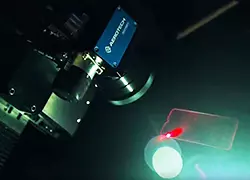What Are the Applications of Laser Cutting? | Materials & Use Cases
What are the applications of laser cutting? Laser cutting is one of the most versatile and widely adopted technologies in modern manufacturing,...
Work with our team to determine which products or systems are the best fit for your application.
Some Aerotech products are available for immediate order in North America through our partner Motion Plus.

A case study examining display production that optimizes quality and throughput – and lower total cost.
2 min read
 Bryan Germann
Jun 30, 2025 2:28:46 PM
Bryan Germann
Jun 30, 2025 2:28:46 PM
The manufacturing process of laser cutting is a highly advanced method that uses a focused beam of light to sever materials with exceptional precision and quality. As a cornerstone of modern industry, this thermal-based, non-contact process has become essential for creating everything from intricate electronic components to large-scale automotive parts. It involves a sequence of carefully controlled steps that transform a digital design into a physical object.
At its core, the process relies on the precise delivery of laser energy to melt or vaporize material, which is then removed by an assist gas. This entire precision laser material processing operation is automated and driven by sophisticated motion control systems, making it a fast, flexible and reliable manufacturing solution.
In the manufacturing process, laser cutting is a subtractive fabrication method. This means it creates parts by removing material from a larger block or sheet. The question what is laser cutting can be answered simply: it is the use of a laser as a high-precision, high-energy cutting tool.
Unlike traditional mechanical cutting that uses blades or saws, laser cutting uses light. A powerful laser beam is focused to a tiny spot, creating an immense energy density that allows it to cut through a wide range of materials. The process is integrated into a larger manufacturing workflow that starts with a digital computer-aided design (CAD) file and ends with a finished, precisely cut part.
A powerful laser beam is focused to a tiny spot, creating an immense energy density that allows it to cut through a wide range of materials.
Lasers cut through materials by delivering a highly concentrated dose of thermal energy. The process can be broken down into a few key stages:
Energy Absorption: A laser beam is focused onto the material's surface. The material absorbs the light, which is instantly converted into intense heat in a very localized area.
Melting and Vaporization: This heat rapidly raises the material's temperature past its melting and boiling points, creating a narrow channel of molten and vaporized material called a kerf.
Material Ejection: A high-pressure assist gas (like oxygen or nitrogen) is directed into the kerf. This gas jet forcefully blows the molten material out of the cut zone, clearing the path for the beam.
Controlled Motion: A CNC (Computer-Aided Control) system guides the laser beam along a programmed path. The speed of this motion is a critical parameter. Manufacturers often use a laser cutting speed calculator to determine the optimal traverse speed based on the material type, thickness and laser power to ensure a clean, efficient cut.
The flexibility and precision of laser cutting have made it indispensable across numerous industries. The uses of laser cutting are vast and continue to expand as the technology evolves. Some of the most common applications include:
Sheet Metal Fabrication: Cutting parts from steel, aluminum and other alloys for automotive bodies, electronic enclosures and industrial machinery.
Medical Device Manufacturing: Creating intricate components like cardiovascular stents and surgical tools where precision and a smooth, burr-free finish are critical.
Electronics: Depaneling printed circuit boards (PCBs) and cutting delicate flexible circuits with high accuracy.
Aerospace: Profiling lightweight components from specialty alloys with complex geometries.
Signage and Architecture: Cutting custom signs, decorative panels and models from materials like acrylic and wood.
While laser cutting is a powerful and versatile process, it does have limitations. The main disadvantage of laser cutting is its sensitivity to material thickness. While lasers excel at cutting thin to medium-thickness materials with high speed and quality, their effectiveness can decrease as the material gets thicker.
For very thick metal plates, the laser may struggle to eject molten material from the bottom of the cut, which can lead to a rougher edge finish, a wider kerf and a larger heat-affected zone (HAZ). Furthermore, maintaining tight dimensional accuracy can become more challenging in thicker sections. A laser cutting tolerance chart will typically show that achievable tolerances become looser as material thickness increases. For these heavy-duty applications, other processes like plasma or waterjet cutting may be more suitable.
What are the applications of laser cutting? Laser cutting is one of the most versatile and widely adopted technologies in modern manufacturing,...
What Is a Galvo Laser Used For? A galvo laser scan head is a powerful and versatile tool used across a wide range of high-precision manufacturing...